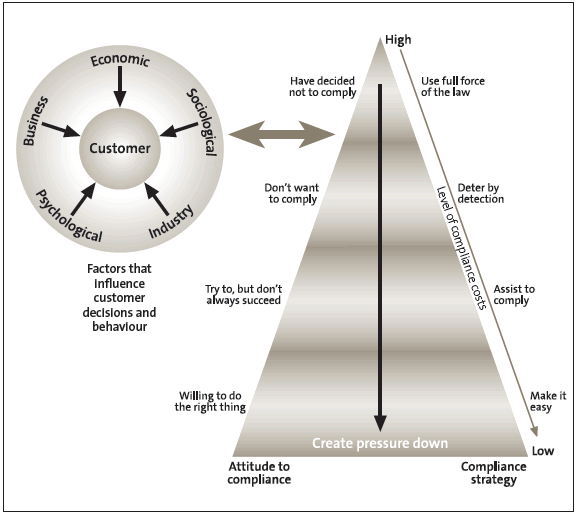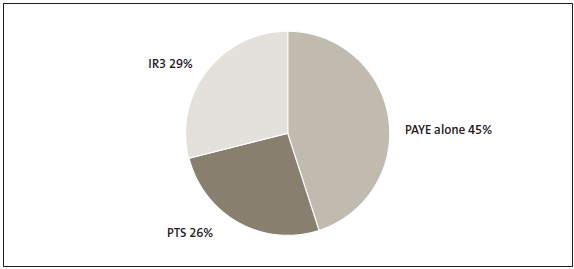Part 1: Introduction
1.1
We became interested in how the Inland Revenue Department (Inland Revenue) is carrying out its strategy to support voluntary compliance during the course of our 2010 performance audit Inland Revenue Department: Managing child support debt. That audit found that Inland Revenue could better explain the child support scheme to support compliance.
1.2
The tax system is most effective and efficient when taxpayers1 voluntarily pay their tax on time and in full. Therefore, part of Inland Revenue's strategy to support voluntary compliance is to make it easy for taxpayers to comply with their tax obligations. In its Annual Report 2009, Inland Revenue states:
An important part of our compliance approach is making it easy for customers to comply. We continue to do this by providing information and services online and delivering direct contact services by telephone, counter visits and community advisories. Making it easy for our customers to comply is more efficient for them and us and helps to reduce compliance costs.2
1.3
We carried out a performance audit to see how effective Inland Revenue is in making it easy for taxpayers to comply with their obligations to pay tax. As part of the audit, we tested Inland Revenue's website with two groups of taxpayers – tradespeople and rental property owners – who had new tax obligations. Both groups are liable for income tax, and may also be liable for Goods and Services Tax (GST). We also reviewed some of Inland Revenue's guides and forms, and made some "secret shopper" calls to its contact centre.
1.4
In Figure 1, Inland Revenue's compliance model for collecting tax shows how taxpayers' attitudes about compliance relate to the actions Inland Revenue uses to encourage compliance. It shows, for example, that Inland Revenue tries to make it easy for taxpayers who are "willing to do the right thing".
1.5
About $246 million of the 2010/11 Vote Revenue appropriation is spent on informing the public about their entitlements and their tax obligations. This appropriation helps Inland Revenue to support voluntary taxpayer compliance.
Compliance for most taxpayers is straightforward
1.6
Most people pay income tax automatically through deductions from a salary or wage using the "pay as you earn" (PAYE) system. For the 2010 tax year, about 1.4 million people paid tax this way. Therefore, for those who receive only a salary or wage, voluntary compliance is generally straightforward and requires little or no effort.
1.7
Some people receive income from sources other than a salary or wage. This may include income from investments such as a rental property or income from business activities. These taxpayers need to file a tax return to report their income to Inland Revenue. Taxpayers do this by filing either a personal tax summary (PTS) or an IR 3 tax return. They then pay tax on their total annual income.
Figure 1
Inland Revenue's compliance model for collecting tax

Source: Inland Revenue.
1.8
For the 2010 tax year, about 474,000 people were required to file a PTS and a further 343,000 filed a PTS voluntarily, often through a tax refund specialist. For the same year, about 901,000 people filed an IR 3. Of those filing an IR 3, 144,000 declared rental income and about 127,000 declared income from self-employment.
1.9
Figure 2 shows the percentage of taxpayers finalising their tax by PAYE alone, a PTS, or an IR 3.
Figure 2
How taxpayers finalised their income tax in 2010

Source: Inland Revenue.
Making it easy to file a tax return
1.10
A taxpayer who understands their tax obligations is more likely to pay their tax than a taxpayer who cannot understand their tax obligations. Inland Revenue's strategy of making it easy to comply is important because, in most instances, the first action needs to come from the taxpayer. If a taxpayer does not know that they need to file a tax return, they will not do so. If a taxpayer finds it difficult to learn about or understand their tax obligations, they may not file a tax return.
1.11
Some taxpayers have a high risk of non-compliance. For example, those who receive income and pay expenses on a cash basis. In our view, Inland Revenue's strategy of making it easy to comply is particularly relevant for these taxpayers. If they do not pay their tax voluntarily, the money they owe to the Crown may never be collected.
1.12
When a taxpayer does not voluntarily comply with their tax obligations, Inland Revenue must take steps to enforce compliance. Enforcing compliance is less efficient and adds to the cost of collecting tax. About $273 million of the 2010/11 Vote Revenue appropriation is spent on auditing taxpayers' income, and managing debt and outstanding returns.
Tax debt
1.13
When a taxpayer does not pay their tax on time, Inland Revenue considers that taxpayer to be in debt. The debt incurs penalties and, as the debt increases and ages, it becomes harder to collect and is more likely to be written off.
1.14
In its Annual Report 2010, Inland Revenue reported that about $4.6 billion in outstanding tax debt was owed to the Crown. In the same year, Inland Revenue wrote off about $619 million in tax debt as uncollectable. Inland Revenue will write off tax debt:
- in cases of serious hardship;
- when it has recovered all it can; or
- for administrative purposes, such as writing off debts of very low value.
How we carried out our audit
1.15
Tax law can be complex, and Inland Revenue needs to administer all aspects of tax law. We did not assess all of the aspects that Inland Revenue administers. Instead, we focused on how easy it is for two groups of taxpayers to pay their tax. These groups of taxpayers are individuals who are about to start receiving income for the first time from:
- a rental property; or
- self-employment.
1.16
In the 2010 tax year, 33,673 taxpayers declared income from self-employment or from a rental property who had not declared this type of income in the previous four years. We have focused on taxpayers who face these new tax obligations because this type of income is common and the risk of non-compliance by taxpayers who are self-employed is high. It also allowed us to assess how easy it is for taxpayers to understand their new tax obligations.
1.17
We set our audit expectations based on our view that, to effectively implement its strategy of making it easy for taxpayers to comply, Inland Revenue needs to:
- take a co-ordinated approach to communicating with taxpayers and provide them with the information they need when they need it, using appropriate and cost-effective communication channels;
- produce written and online materials for taxpayers that are clearly structured and written so taxpayers can easily understand them; and
- make sure that the telephone support it provides to taxpayers is easy to access and provides accurate and timely information.
1.18
To assess the first aspect, we reviewed relevant documents and reports produced in New Zealand and overseas to help us understand the communication approaches taken by others. We then interviewed staff at Inland Revenue and reviewed public and internal documents and reports. We also looked at the reporting activities that Inland Revenue uses to monitor its performance.
1.19
To assess the second aspect, we took two approaches. First, we hired an independent research firm to conduct website user testing with taxpayers based in Auckland. The user testing allowed us to understand how easily the participants could find materials on Inland Revenue's website and how helpful those materials were.
1.20
Secondly, we collated some good practice expectations about how documents should be presented to the public and assessed some of Inland Revenue's documents against these expectations (see Appendix 1).
1.21
To assess the third aspect, we reviewed the performance information that Inland Revenue collects to monitor its contact centre and the quality assurance measures that it uses to monitor the performance of its staff. We also conducted some "secret shopper" telephone calls, which allowed us to examine the performance of Inland Revenue's contact centre.
1.22
For all of our findings, we considered the consistency of information from our sources. We also looked at how well that information aligned with our expectations. Our analysis of how well Inland Revenue met our audit expectations is the basis for our judgement on how effective Inland Revenue is in making it easy for taxpayers to comply with their tax obligations.
What we did not audit
1.23
We did not audit:
- the interactions or materials Inland Revenue produces or provides for tax agents;
- obligations relating to PAYE or any other forms of tax other than personal income tax and GST;
- obligations of entities other than individuals or sole traders, such as companies or trusts; and
- any aspects of Inland Revenue's contact centre not discussed in this report.
1: For ease of reading, we use the term "taxpayer" to refer to individuals with tax obligations irrespective of whether they currently comply.
2: Inland Revenue Department (2009), Annual Report 2009, page 25.
page top
